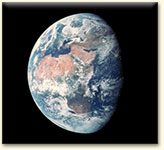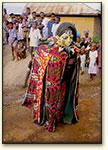African Art

Earth, showing Africa, Europe, and Asia taken from the Apollo 11 spacecraft during its translunar insertion. The spacecraft was about 98,000 nautical miles from Earth when this picture was made.
The long, complex history of settlement within Africa, commencing with the emergence of homo sapiens in eastern Africa, has produced cultural diversity unlike that of any other continent. Africa is a vast landmass with a population of about 885 million people who speak more than 1,000 different languages, each linked to particular ethnic groups and communities. One cannot generalize about African art and culture. Egyptian, Sudanese, and Ethiopian art forms, responding to Mediterranean cultures, Christianity, and Islam are utterly different from the arts of West or southern Africa.
Before 19th-century western colonialism brought Europe into direct contact with sub-Saharan Africa, communities created and used art in ways relating to their African worldviews, as well as their functional and decorative needs. Africans who had not experienced much contact with European cultures of ancient or modern times shared the opinion that art was not produced exclusively for philosophical inquiry, aesthetic contemplation, or narrative reasons. Visual creativity was associated with the applied and decorative arts (such as textiles, jewelry, pottery, artifacts, and furniture) and – through costumes and masks – it fulfilled important spiritual functions in ritualistic and ceremonial activities.

The Yoruba egungun masquerade (modern Nigeria) is remarkable for its dizzyingly colorful textile costumes, designed to create spectacular ritual performances.
In the West, from the Renaissance to the 19th century, paintings were understood as objects requiring visual scrutiny; they were expected to yield information about the world of empirically verifiable external reality or to generate discussion about myth, legend, and history. To facilitate the representation of three-dimensional visual experience on flat surfaces, artists used scientific systems such as linear and aerial perspective and the color theories devised by Leonardo da Vinci, Newton, Goethe, and Chevreul. Rational inquiry, so highly prized in the West, influenced the visual arts, resulting in illusionistic art that seemingly renders “real” form and space (Jan Vermeer, The Milkmaid).
The naturalism and rational logic of Western art is seldom apparent in African art, with the notable exception of 12th and 13th-century Yoruba Ife terracotta heads. Most sculpture is stylized and symbolic because it expresses the sacred.
In traditional African communities relatively unaffected by non-African cultures and modern urbanization, the boundaries between terrestrial existence and the spiritual realm are not clearly differentiated. Events in the world are explained by the intervention of powerful, unseen ancestral forces, and of good and evil. The spirit world is manifested through performance art; music, dance, drama and images are integrated in masquerades. Visual creativity is expressed through artifacts and costumes with masks, designed to inculcate fear, awe, and reverence in spectators and participants.
African art forms are functional and interrelated. For this reason African sculptures and textiles seen in static isolation in museum collections become visual objects with different meanings than those generated by use in communities. Documentary photographs of masquerades clearly indicate the importance of color as an element appealing to the senses. It is important to note that although ceremonies are based on “tradition,” those traditions are not fixed. Rather, they evolve in response to changing environments. This has particular importance for the visual element within ritual ceremonies. As cloth, beads, and objects were traded, the maskers incorporated new textures, forms, and colors into their costumes. Therefore, modern ceremonies are more colorful than those of the past, since a much wider range of machine-printed patterns and cloth, dyed with synthetic colors, are now available. Color has become more significant, stimulating the eyes and enhancing emotions that are activated by rhythmic drums, human voices, and dynamic bodies. African “art” is not for the eyes alone.